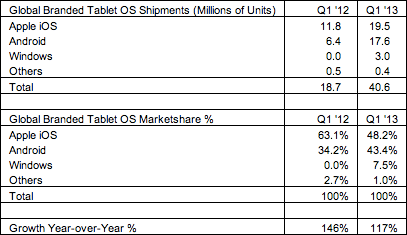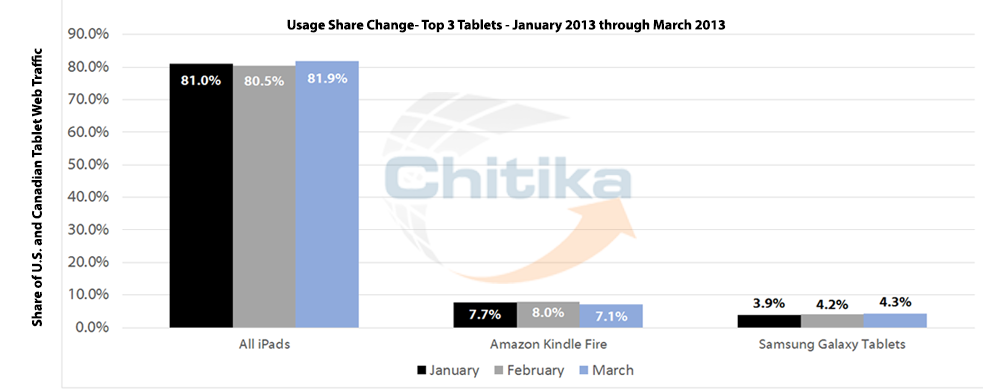Let the post-mortem begin. It is a ritual on Wall Street: forecast Apple’s quarterly numbers, then afterwards dissect the data the iPad maker releases. And once more, the coverage conflates shipment with usage to determine the status of Apple or Android.
Although Apple Tuesday announced selling 19.5 million iPads during the first quarter of 2013 – an improvement from 11.8 million tablets sold during the same three-month period in 2012 – the focus Wednesday was on the iPad shedding market share to Android. But do unit sales trump actual usage?
According to Strategy Analytics, Apple’s share of the global tablet market in the first quarter shrank to 48.2 percent, down from 63.1 percent during the same quarter in 2012. The research firm estimates Apple shipped a robust 19.5 million mixed iPads worldwide.
Strategy Analytics analyst Peter King said Apple produced a “solid performance” this quarter as the iPad mini had its first full term. By contrast, Android’s share of the tablet market rose to 43.4 percent, up from 34.2 percent. Global Android tablet shipments increase 177 percent annually to 17.6 million units.
Chart via BGR.
Overall, global tablet shipments reached a record 40.6 million units during the first quarter, up 117 percent from the 18.7 million tablets shipped during the first quarter of 2012.
At the same time some were bemoaning Apple’s slumping global market share, others hailed the iPad maker for dominating tablet usage online.
As we wrote earlier today, the online advertising network Chitika announced the Apple device held 81.9 percent of tablet-based web traffic in the US and Canada in March 2013. Amazon’s Kindle Fire, which uses a customized version of Android, came in a very distant second-place with 7.1 percent of tablet traffic online.
This is just one example of what I call the real smartphone dichotomy.
While Apple’s iOS and Google’s Android are commonly referred to as holding a smartphone duopoly, Android devices tend to be purchased, then gather dust while iOS products show up online more often. Some observers, such as TechCrunch’s Sarah Perez call it the Android Engagement Conundrum.
Some believe there are quite a few Android owners who simply don’t use their phones like smartphones. IBM’s Black Friday 2012 data seems to back this up. These users are phone-first, and ‘smartphone’ second.
Engagement seems to be where iOS really shines.
Not only do IOS users go online more often, they use their tablets and smartphones in ways totally different than Android users. TechCrunch interviewed a number of app developers who have created iOS products before Android – even though the Google mobile OS has a numerical superiority.
Which brings us back to why bean-counting just doesn’t work to gauge who is ahead in the tablet race. Android tablet makers need to find a way to convert their customers from owners to users – a tactic where Apple currently holds a wide lead.


